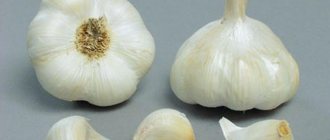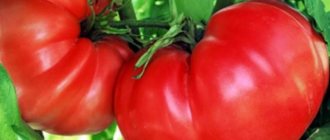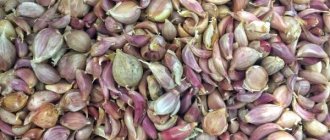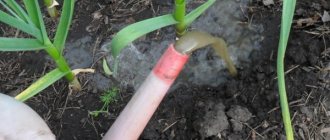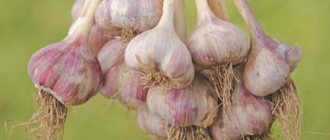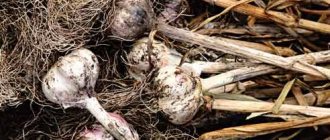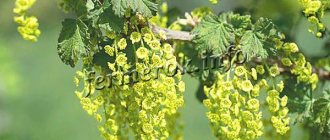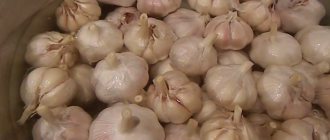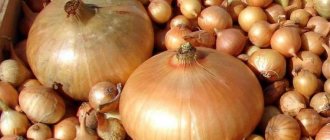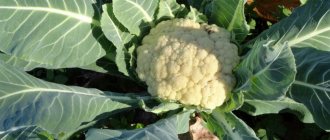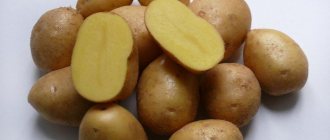Dobrynya garlic is a prominent representative of winter varieties. It bears fruit early, is hardy and unpretentious. Refers to bolting garlic. Suitable for cultivation in all regions of the Russian Federation. The variety is equally good for growing in home gardens and farm plots.
late-ripening winter variety of garlic “Dobrynya”
a head of Dobrynya garlic weighs up to 65 grams
variety "Dobrynya" is resistant to cold weather conditions
Description of the variety and its characteristics
The Dobrynya variety is a late-ripening garlic of universal use. It ripens in August-September, so it is actively used for preservation. It is also eaten fresh, in the form of seasonings, and pickled.
Description of culture:
- Leaves. Meaty, juicy. Color – rich green. There is a waxy coating. Length – 40-60 cm. Width – 2-2.5 cm.
- Inflorescences. They consist of aerial bulbs - seeds used for propagation. Inflorescences appear on long arrows, which usually have a noticeable curvature.
- Head. The shape is round, slightly flattened. Covered with faded gray scales with pale lilac veins. The teeth are covered with scales with a more pronounced purple tint. The pulp is pale cream, dense, aromatic and juicy. The taste is sweetish-spicy.
Agrotechnical characteristics of Dobrynya garlic:
| Characteristics | Options |
| Ripening time | late-ripening |
| Growing season, days | 120-130 |
| Weight of heads/teeth, g | 50-65/5-7 |
| Number of teeth in the head, pcs. | 10-12 |
| Productivity, kg/sq. m | 2-2,5 |
Garlic heads of the Dobrynya variety contain 40% dry matter and 24% sugar. 100 g of garlic contains 10 mg of ascorbic acid. Nutritional value – 144 kcal per 100 g.
Non-shooting varieties of winter garlic
Non-shooting varieties are characterized by a slightly larger number of medium-sized cloves arranged in a spiral in one row. The main difference from the previous group of bolting garlics is the absence of seeds, and, therefore, reproduction occurs only by cloves.
Early ripening varieties produce a harvest already at the beginning of summer, often even at the end of May.
Doctor
After 100-109 days it is already possible to harvest. The weight of the head can be from 35 to 65 g and contain quite a lot of cloves - 11-18. The harvest can be stored well for more than six months without reducing its properties. By growing garlic of this variety, you can regularly obtain a stable harvest.
Sail
Gives very good yields, about 1-1.5 kg per 1 square meter. Winters well. No more than 6-8 cloves are formed with a total weight of up to 40 g. The length of the leaves is 50 cm. The pulp is very juicy, very spicy and overly fragrant. Garlic heads of this variety overwinter very well and can be stored in the basement for six months and often, under proper conditions, for up to 8 months. Does not reduce its productivity when cultivated in shaded summer cottages. The plants are low, about 50 cm, and are practically not affected by any pathogens.
Broadleaf 220
An old domestic garlic, still popular among summer residents for its high resistance to cold weather during cultivation. The head has from 8 to 10 cloves, semi-sharp in taste, which are fully formed already on the 97th day. It is immune to fusarium, but is not resistant to rust. The main significant drawback is low yield, less than half a kilogram per square meter.
Dutch varieties
Varieties of Dutch selection are becoming increasingly common. The most famous among our gardeners are Hermidor and Messidor.
Both varieties are early ripening, high-yielding, distinguished by a round garlic head weighing 60-90 g (Germidor), slightly larger in size - from 100 to 150 g, it is in the Messidor variety. By growing Dutch varieties, you can get about half a ton of high-quality bulbs from an area of one hundred square meters.
These “Dutch” products are extremely in demand among producers of garlic products of high taste and commercial quality for commercial purposes. Plant height is 40-60 cm. The heads usually have 10-12, sometimes 15 cloves arranged in two rows. Garlic ripens at the beginning of summer.
According to reviews from summer residents, the varieties are not only very productive, but also resistant to the main diseases of garlic: bacteriosis, white rot and mold. They have high frost resistance and can withstand frosts down to – 15 °C. The color of the pulp is white-pink.
Although they are considered unpretentious to growing conditions, they prefer areas open to sunlight, sufficiently illuminated, and will also gratefully respond to increased yields when fertilized with urea.
Photo: Dutch variety Messidor
Mid-season varieties: Losevsky, Pamyati Ershov, Bogolepovsky, German
Losevsky
Frost-resistant variety. Full filling and ripening of the bulbs takes place in 105-115 days. Main characteristics: yield – 1.3-2.5 kg per square meter; The weight of the head is on average 75 g, the number of cloves is 4-5. Can be stored for no more than six months.
In memory of Ershov
Up to 1.9 kg is collected per square meter. Overwinters well in soil. The medium-sized heads (55 g) contain a large number of cloves, up to 20, with a medium-sharp taste. The main disadvantage is the short storage period - less than 5 months.
Bogolepovsky
A well-known and popular Russian variety. It has good yields, up to 2.5 kg per 1 sq. m. Quite large, flattened heads are formed from 10-12 cloves. In cool conditions it retains its properties for a long time. Does not impose special requirements on growing conditions.
Hermann
Main characteristics: weight of the garlic head – up to 50 g, number of cloves – 6-7, average yield per square meter – about 1 kg. Cream color and pungent taste are the main qualities of the pulp of this variety.
Dobrynya
Late ripening variety. Very popular for stable high yields (at least 2-2.5 kg/m2) and increased cold resistance, tolerates sudden temperature changes. It takes a long time to ripen – about four months. Large bulbs weighing 50-55 g consist of 10-12 cloves. It is widely used in cooking and medicine for its excellent taste and healing properties. Highly resistant to major garlic diseases. Can be stored for up to 6-7 months.
Photo: Dobrynya variety
Advantages and disadvantages of the Dobrynya variety
Eating garlic improves immunity, lowers cholesterol and blood sugar levels, and fights inflammatory and tumor processes.
Advantages of the Dobrynya variety:
- high productivity;
- large head size;
- long shelf life;
- immunity to many fungi and other garlic diseases;
- high frost resistance, tolerates sudden temperature changes;
- versatility of use - used in cooking, is an excellent anti-cold remedy;
- excellent taste;
- possibility of self-renewal of the variety.
Flaws:
- drying out and rotting after 4 months of storage;
- tendency to degeneration.
Features of planting garlic
The quality of grown garlic depends on many factors:
- Landing dates. It is advisable to plant garlic 1-1.5 months before serious frosts. For each region, the disembarkation time is determined individually. In the middle zone, winter garlic is planted starting in September and ending in mid-October.
- Temperature. Optimal conditions for planting occur when the soil warms up to +12…+13 °C.
- Soil qualities. Garlic is responsive to fertile soils. Prefers sandy loam soils or light loams.
- Predecessors. Winter garlic grows well after strawberries, wild strawberries, potatoes and tomatoes. It is not recommended to plant after carrots, onions, lettuce, celery, radishes, spinach, turnips, herbs - cilantro, mint, coriander, basil.
- Lighting. Garlic loves the sun, so it is planted in open, well-lit places.
Why is it important to plant winter garlic on time:
- If you plant garlic too early, it will sprout and freeze at the first frost.
- If you delay planting, the planting material will not have time to properly take root. And even if they successfully overwinter, they will not grow actively enough in the spring.
Preparing the site
The area for planting garlic is prepared 2-3 weeks before planting - so that the dug up soil settles. Garlic planted in too loose soil grows small and does not last long.
To increase the productivity of Dobrynya, during digging the soil is enriched with rotted manure or compost. You can also add to depleted soils:
- superphosphate – 30-50 g per 1 sq. m;
- potassium – 15-20 g per 1 sq. m;
- complex fertilizers.
Before planting garlic, you cannot fertilize the soil with fresh manure - only rotted manure.
Garlic does not like heavy soils, and to make them more airy, add peat or sand. Without being particularly capricious, Dobrynya does not like dry, depleted soils.
Preparation of planting material
Preparation of planting material begins with inspection - if a batch of garlic prepared for planting has a large percentage of spoiled cloves, it is rejected. There should be no signs of rot or stains on the teeth. The largest heads are selected for planting. Shortly before planting, the heads are disassembled into cloves; if there are a lot of them, then the largest ones are selected.
You should not plant heads with 3-4 cloves - this is a sign of degeneration of the variety.
To ensure that the heads grow large and do not get sick or rot during storage, they are treated with disinfecting solutions before planting. For this purpose they usually use:
- A weak solution of potassium permanganate. The color of the liquid should be slightly pink. Planting material is immersed in the solution for 0.5-1 hour.
- Copper sulfate solution 1%. The teeth are soaked for 10 hours. If you soak the cloves overnight, they will be ready to plant in the morning.
- Table salt solution. 3 tablespoons of salt are dissolved in water (5 l). Immerse the cloves for 2-3 minutes.
- Ash solution. For 1 liter of water - a glass of ash. Soak the seed material for 1 hour.
- Purchased drugs: “Maxim”. It acts like an antibiotic, but the composition is natural. For 1 liter of water – one ampoule. The effect lasts for the entire growing season.
- "Fitolavin". Protects against bacterial infections, root rot, fungal diseases.
Planting garlic in the ground
Garlic is planted in rows, between which gaps of 20-25 cm are left. Seed material is planted at intervals of 12-15 cm. The planting depth should be such that the garlic can safely overwinter. To do this, the cloves are sunk into the ground so that there is a 4-5 cm layer of soil above them.
When planting, you should not press the cloves with force - if you press them too hard on the soil, this will slow down the development of the root system.
Garlic plants are planted bottom down. Sprinkle soil on top. There is no need to water the autumn planting. In regions with particularly cold winters, another measure is required - mulching. After planting, the beds are sprinkled with mulch - sawdust, straw, and plant debris are suitable.
Features of agricultural technology
In order for the well-loosened soil to settle before planting the cloves, they begin to prepare the area for garlic half a month before planting. It is highly not recommended to plant seeds in soil that is too loose - the heads grow small, and the shelf life is much shorter than indicated in the characteristics of the variety.
If it is necessary to enrich the soil with useful substances, rotted manure or compost is added to the site.22
Preparation of planting material
Before planting, you need to carefully examine the teeth for damage in the form of yellow spots, areas of mold and rot. The gray bottom should be clean and smooth. Sick teeth are not used for planting.
Planting material should be selected from large heads - the larger the cloves, the greater the likelihood of reaping a generous harvest.
Most often, winter garlic is planted in rows that are located 20-25 cm apart. The recommended spacing between plants is 12 - 15 cm. The depth of the row should be such that there is a layer of soil above the cloves of at least 3-5 cm. Failure to comply with this agrotechnical requirement may result in freezing of seeds or cloves.
After planting, the bed is not watered. In regions with harsh winters, the area is mulched with straw, sawdust, corn or sunflower tops. To ensure unimpeded access to air, sunlight and water, the mulch is removed when spring arrives.
Cultivation care
Caring for Dobrynya garlic includes regular loosening of the soil, watering, removal of weeds and fertilizing.
During the first spring loosening of the soil, ammonium nitrate is added to the site at the rate of 10-15 grams per 1 m2.
Half a month after the first feeding, 30-40 g of Nitroammofoska are added to the crops, which is diluted in 10 liters of water. Around mid-summer, when the head is in the active growth stage, the plant is fertilized with a Superphosphate solution of the same concentration as the previous solution.
In order for the garlic to ripen faster, the bulbs are exposed a little a few days before digging them up. In June, Dobrynya garlic produces arrows that must be trimmed before their height reaches 10 cm. Thanks to this action, the volume of the harvest triples.
Harvest and storage
As soon as the tops turn a little yellow and bend down, and the scales become dense, the garlic is fully ripe and needs to be dug up immediately. Harvesting cannot be delayed for a long time, since the cloves of overripe bulbs are separated from the stem, causing the bulb to disintegrate.
When the weather is dry and warm, the garlic is laid out on burlap in the open air.
Bulbs are stored in well-ventilated, dry rooms where the temperature does not fall below 0C. The optimal temperature for long-term storage of garlic is 0-+3C. Garlic is placed in nets or boxes in a low layer.
The culture has a number of advantages that distinguish this garlic from a wide variety of cold-resistant varieties.
Caring for Dobrynya
Caring for Dobrynya garlic consists of the usual activities for this culture:
- Watering. Irrigation is moderate. Watering frequency – 2 times a week. Do not over-moisten the soil.
- Loosening. Prevents the top layer of soil from drying out and the formation of a hard crust. Loosen the soil about an hour after watering.
- Removing weeds. Weeding is done as needed until harvesting. If weeds are not removed on time, garlic grows poorly and its heads become smaller.
- Feeding. It is added when the garlic is actively growing. They stop feeding the crop when the ripening period begins, so that the quality and taste characteristics do not deteriorate. The first feeding is 10 g of ammonium nitrate per 1 sq. m.
- The second feeding is carried out at intervals of 2-3 weeks. The beds are watered with a solution of nitroammophoska - 40 g per 10 liters.
- The third feeding is carried out around mid-July. Water with superphosphate solution - 40 g per 10 liters.
How to plant Dobrynya garlic correctly?
Dobrynya garlic is intended for open ground. It should be planted in neutral acidity, loamy soil. In all other types of soil, the variety gives lower yields, but will still develop successfully, especially with high-quality care. The land for planting must be fertilized if it is depleted of useful substances. The best fertilizers will be superphosphate (40 g/m2) and potassium (15-20 g/m2).
The planting location should be either sunny or in partial shade. A few hours daily in sunlight is essential for this type of garlic, otherwise the taste will be bland and the ripening of the head may be delayed. The time for sowing Dobrynya garlic usually occurs in mid-autumn or late September. It is necessary to plant it in such a way that there are 2-3 weeks left before frost, otherwise it will not have time to take root, and if you plant it ahead of schedule, it will simply germinate and freeze.
Planting Dobrynya garlic using a tractor and seeder
Dobrynya garlic is propagated by cloves, aerial bulbs (seeds), and single-clove heads. To get a full-fledged head, it is necessary to sow the teeth or single-tooth heads obtained a year after sowing the aerial bulbs. It is worth noting that you can easily take seed from the harvest, but every 4-5 years it is necessary to update the variety, otherwise its characteristics will deteriorate greatly.
Plant garlic at a distance of 10-20 cm from each other. The cloves are buried approximately 4-6 cm. It is not recommended to treat garlic before planting, but it is worth selecting only large, whole seed material. On top of the plantings, the bed must be mulched with a layer of organic mulch (leaf, straw, peat, sawdust).
Diseases, pests and their control
The Dobrynya variety has high immunity, so it is rarely affected by fungal and viral diseases. To obtain large harvests, preventive measures are sufficient.
Symptoms and methods of controlling pests and diseases of Dobrynya garlic
| Pests and diseases | Symptoms of the lesion | How to fight? |
| Stem nematode | Garlic leaves dry out and roots rot. The pest is a small white worm 1.5 mm long. | Plant calendula between rows. Before planting garlic, water the soil with a salt solution (3 liters - 20 g). Add peat or sand to clay soils. |
| Root mite | It most often affects heads in storage, but can also eat heads in the garden. | Purchase healthy planting material. Burn plant residues. Treat the storage facility with sulfur dioxide. |
| Onion fly | Lays eggs at the base of leaves. The larvae eat the head and young scales. The plant grows slowly at first, then dries and dies. | Plant carrots nearby. Onions are an undesirable precursor. Sprinkle the soil with a mixture of ash and tobacco, with the addition of mustard or pepper. Water with salt solution - take 250 g of salt per 10 liters. |
| Fusarium | Occurs against the background of excessive moisture. Accompanied by yellowing and wilting of leaves. The heads become loose and slimy and are easily pulled out of the ground. | Maintaining crop rotation. Treat the soil with fungicides 2 weeks before planting. At the first signs of disease, spray the plantings with fungicides. Thoroughly dry the heads before storing. Bulbous plants cannot be planted in one area for more than 5 years. |
| White rot | Appears during storage. The cloves become soft and rot. | Cleaning beds from plant debris. Disinfection of the soil before planting garlic using the “Hom” product. During the growing season, water with a solution of Fitosporin-M. |
Diseases and pests, methods of control and prevention
Garlic of the Dobrynya variety is rarely attacked by pests and practically does not get sick if you follow basic agricultural cultivation techniques. But during the process of active growth in summer, cases of damage cannot be excluded: fusarium, root rot. Particularly dangerous parasites are: root mites, nematodes, onion flies and hoverflies.
The cause of fusarium wilt is excessive moisture, against the backdrop of consistently warm weather. You can tell that garlic is withering by its yellowing and wilting leaves. The affected heads become loose, slimy and are easily removed from the soil.
Rot occurs during storage of garlic. The teeth soften, become covered with small ulcers and partially rot.
Since garlic is eaten, treatment with fungicides and insecticides is unacceptable. The only way to combat diseases and pests is to plant healthy material, proper care, and adherence to the principles of crop rotation. Diseased plants are dug up and disposed of. After this, the plot cannot be planted with garlic for the next 4 years.
Reproduction methods
Dobrynya garlic is propagated vegetatively - by cloves. The teeth are selected from the largest heads so that the harvest is larger. Over time, the variety degenerates, losing its original qualities. To save the varietal characteristics, an update is necessary - instead of cloves, aerial bulbs are planted. They grow on shoots, in inflorescences.
It is recommended to renew garlic plantings with onions every 3-4 years. Aerial bulbs are collected from garlic shoots in the spring, during shooting. One-toothed heads grow from the bulbs the following year. They are planted in the fall, and full-fledged heads grow from them.
Harvest and storage
Harvesting begins in July - the timing differs in different regions. Gardeners focus not only on timing, but also on the appearance of garlic. If the tops turn yellow and begin to droop towards the ground, it’s time to harvest. You cannot be late with cleaning. If the heads become overripe, they will begin to disintegrate into cloves, separating from the stem, making harvesting difficult.
The best weather for harvesting is dry and sunny. The torn/dug up garlic is laid out to dry - in the open air. If the weather is cloudy, it is better to harvest the crop under a canopy. When the leaves are dry, cut them off, leaving a couple of centimeters. The roots are also cut off.
Conditions for long-term storage:
- dry, well-ventilated room;
- temperature – from 0 to +4 °C;
- garlic is laid out in nets or small boxes.
The heads are stored for about 4 months. During this time, the heads do not deteriorate at all - if the crop is stored without damage or disease. At 5-6 months, the heads gradually begin to deteriorate - approximately 20% have to be discarded. To prevent garlic from going to waste, it is processed or consumed on time.
Garlic variety Dobrynya: characteristics, planting and care
Among domestic gardeners, growing winter varieties of garlic is more common than planting spring varieties. Garlic of the Dobrynya variety is deservedly popular among vegetable growers for its unpretentiousness, winter hardiness and high yield.
Garlic variety Dobrynya: history of selection
Winter garlic Dobrynya was created by Russian biologists and breeders at the beginning of the 21st century. The variety was registered in the State Register of the Russian Federation in 2002.
The creators sought to obtain a vegetable with a large head, resistant to the main diseases of the crop, and with increased frost resistance. As a result, Dobrynya fully met the hopes of the breeders. The variety is recommended for cultivation in all regions of Russia, regardless of climate.
A powerful plant grows from a clove planted before winter - the leaves are 60 cm long. They are dark green with a bluish tint, hard and rough, 2 cm wide.
On each varietal specimen, an arrow is formed, about a meter high. At the end of it, an inflorescence grows, in which up to 80 seeds - bulblets - ripen.
The head of the vegetable has a spherical shape. Its weight is 80-110 g. The covering scales are grayish-lilac in color. There are up to 10 teeth in the head. They are large, round, covered with a dense yellow-violet shell.
Description of the Dobrynya garlic variety from the manufacturer:
- ripening period from emergence of seedlings 4 months (late);
- high winter hardiness;
- innate immunity to fusarium and bacteriosis;
- the yield reaches 3 kg per 1 sq. m;
- The shelf life of the crop is up to six months.
According to gardeners, plants of this variety tolerate dry summers well, but grow slowly in the rainy season.
According to the given characteristics, the strengths of Dobrynya have been identified:
- resistance to low temperatures in winter, including sudden changes in heat and cold;
- high disease resistance;
- large head size;
- consistently high productivity.
Disadvantages include demanding storage conditions (as the temperature in the storage increases, garlic begins to dry out) and the need to remove the shoots to increase yield.
Garlic propagation
Dobrynya garlic, like all winter varieties of vegetables, can be planted with cloves, seeds (bulbs) and single cloves grown from seeds.
Most often, gardeners resort to planting cloves taken from food heads. This is the easiest and fastest way to get marketable garlic. The disadvantage of this method is the possibility of transferring diseases, along with planting material, to the garden bed. In addition, no more than 10 plants can be grown from one head.
The vegetable is planted in bulbs if it is necessary to propagate the variety with little seed material. One plant can produce only a dozen cloves, versus 50-80 bulblets. But it takes 2 years from sowing the seeds to receiving the food head. In the first season, one-toothed garlic, whose diameter does not exceed 3 cm, is removed from the garden bed. Planting it in the fall already leads to the appearance of a large head of garlic for the next year.
Winter garlic is planted from late September to mid-November, depending on fall weather. The optimal time for sowing occurs when the air temperature during the day drops to 5.. 8 degrees. Night frosts are not a hindrance to this cold-resistant vegetable.
The planting bed is prepared on a well-lit and level area. It would be good if cabbage, cucumbers or peas were grown here this year. If garlic is forced to be planted after onions, potatoes or tomatoes, it is necessary to sow an intermediate crop (green manure) to improve the soil health. It could be mustard, oats, salad. The greens that have grown in 4-6 weeks are crushed and plowed into the soil. By rotting, it provides nutrition and frees the soil from infections.
Fertile loam or sandy loam is suitable for garlic. Heavy soils are loosened by adding sand, high acidity is reduced by adding bone meal or ash, 200 g per 1 square meter. m. The addition of rotted manure (vermicompost) or compost for digging, up to 6 kg per square area, will help saturate the soil with nutrients.
Outwardly healthy, medium-sized cloves are suitable as planting material. There is no need to free them from the covering peel. When dividing the head into parts, it is important not to damage the bottom of the cloves with the rudiments of the roots.
The cloves are placed in rows on the bed, with a distance between plants of 25 cm. The row spacing is 30 cm wide. The spacious planting of the cloves promotes the setting of large heads. The depth of immersion of the clove in the soil is from 8 to 12 cm, depending on its size and the severity of the winter (the colder the winter, the deeper the garlic is immersed).
The bulbs are sown according to a pattern of 7 by 10 cm, to a depth of 2 cm.
Garlic begins to grow in the spring, as soon as the snow melts and the soil warms up to 8 degrees. At this moment, it is necessary to loosen the rows, letting oxygen in, to the roots. If there is mulch in the garden bed, it is raked and burned; it has served the function of insulation.
Caring for the plant consists of fertilizing, weeding and watering if the weather does not rain.
Dobrynya is fed 2 times a summer.
- When the foliage grows 20 cm, the vegetable is fed with infusion of chicken manure or urea (1 matchbox per 10 liters of water). Nitrogen fertilizer will speed up the growth of greenery.
- When the garlic stalk increases to 8 mm in diameter, the plantings are fed with phosphorus-potassium fertilizer. For example, 40 g of superphosphate and 20 g of potassium sulfate are dissolved in a bucket of water. You can use an ash solution or an infusion of banana skins.
The Dobrynya variety tolerates a lack of moisture in the soil well, but does not like waterlogging. If it rains, it is necessary to frequently loosen the soil between the rows, facilitating the evaporation of excess moisture.
If you follow the rules of crop rotation, garlic is rarely attacked by pests. The vegetable is pestered by weevils, aphids, onion moths and onion mites, and thrips. The presence of pests can be determined by yellowing of the foliage and the general depressed appearance of the plant.
To control pests, aqueous solutions of drugs are used: Tagor, Metaphos, Aktara, Fitoverm, Fufanon.
The right time to harvest garlic is when the skin on the head and cloves becomes firm. The foliage turns yellow and dries out. If you are late with cleaning, the head will fall apart and begin to rot. Vegetables harvested early do not store well due to the peel not having time to harden.
Garlic is dug on a dry day, using pitchforks or shovels. You cannot pull the vegetable out of the ground by its leaves; you can tear the stem from the head.
Garlic extracted from the ground is laid out to dry on heated ground or put under a canopy. There it is laid out on grates or hung by the tops. Leave the plant to dry for several days.
After thorough drying, the heads are freed from stems and roots. Using pruning shears, cut the stem at a distance of 3-5 cm from the head, and remove the roots flush with the bottom.
For the winter, garlic is stored in nets, cardboard or wooden lattice boxes. The optimal storage temperature for winter vegetables is 17.. 18 degrees, air humidity 50-55%. At higher temperatures, the teeth begin to dry out.
Like all winter varieties (Lyubasha, Komsomolets), Dobrynya does not have good keeping quality. After 3-4 months the heads begin to deteriorate. To preserve the harvested crop, they resort to processing it. The vegetable is added to marinades and pickles. It is dried and crushed to obtain a finished seasoning, making garlic oil.
Winter garlic Dobrynya occupies a leading position in popularity among gardeners in the northern regions of the country. Its winter hardiness and disease resistance allows you to harvest an impressive harvest in areas with a cold climate.
We invite you to familiarize yourself with Cranberry: description of the plant, garden cranberry, forest cranberry, meaning in nature and forest
Gardeners plant garlic either in the spring, to obtain a harvest at the end of summer, or for the winter. In this case, the garlic heads ripen earlier and grow larger. Dobrynya garlic is one of the varieties that are most often planted for the winter. Let's figure out what attracts gardeners to this variety and how to properly plant, care for, collect and store the heads.
Dobrynya is a late-ripening variety of garlic. Harvesting occurs 130 days after spring germination. Resistant to cold weather conditions, which is why it is so popular in the Russian Federation. The variety is also planted abroad and a high-quality harvest is obtained. The plants are powerful, the leaves reach a height of 55 centimeters. The tops are characterized by a rich green color with a white coating on the feathers. The leaf width reaches 2.5 centimeters.
The variety is propagated by seeds, cloves and bulbs. When cultivated in private plots, the variety gives a high yield - up to 2.5 kilograms per 1 square meter.
A head of garlic reaches a weight of 65 grams, and produces from 9 to 13 cloves. The upper scales are light gray, almost white. The shell of the cloves in the bulb is purple. Peeled garlic cloves are almost white in color and have a creamy tint. The taste is garlicky, sweet and medium spicy.
Due to its positive qualities, the variety is grown not only on private plots, but also on large farms, and gives excellent results. Advantages:
- High yield.
- Frost resistance.
- Resistance to fusarium.
- Quality harvest.
- Wonderful garlic taste and aroma.
There is only one drawback - the variety dries out and rots during long-term storage, so when stored for more than 4 months, 20% of the harvest is lost.
The use of the described variety of garlic Dobrynya among Russian housewives is extensive. This is an excellent seasoning for meat and fish dishes; cloves are added to marinades to give a special taste to cucumbers, tomatoes, mushrooms and salads. Used as an additive to first and second courses. Garlic is also used in folk medicine to treat colds and runny nose.
History of selection
Reviews from gardeners
Gardeners have assessed the Dobrynya variety differently - there are both laudatory reviews and sharply negative ones. Let us take into account that often the gardener himself is to blame for failures in cultivation, violating agricultural cultivation techniques.
★★★★★
Maria P., Kaluga region. I didn't like this variety at all.
It’s harvestable, no doubt about it, and it tastes good, but it doesn’t store well. By spring, for the three years that I raised Dobrynya, I never had any garlic left - it spoiled. But if you use the variety for preparations, then it is ideal. ★★★★★
Evgeniya V., Vladimir region. I liked the Dobrynya variety for its moderate garlic flavor - I don’t like too hot and hot garlic.
There is only one problem - keeping quality. You can’t count on more than 4 months of storage. Otherwise, the variety is ideal - productive, tasty, disease-free, easy to care for. Hide
Add your review
It is not for nothing that Dobrynya garlic is considered one of the best winter varieties. It is productive, unpretentious and easy to grow. Unlike most varieties, Dobrynya is not limited to a specific area - it grows equally well in almost all regions of the country.
0
0
Copy link
